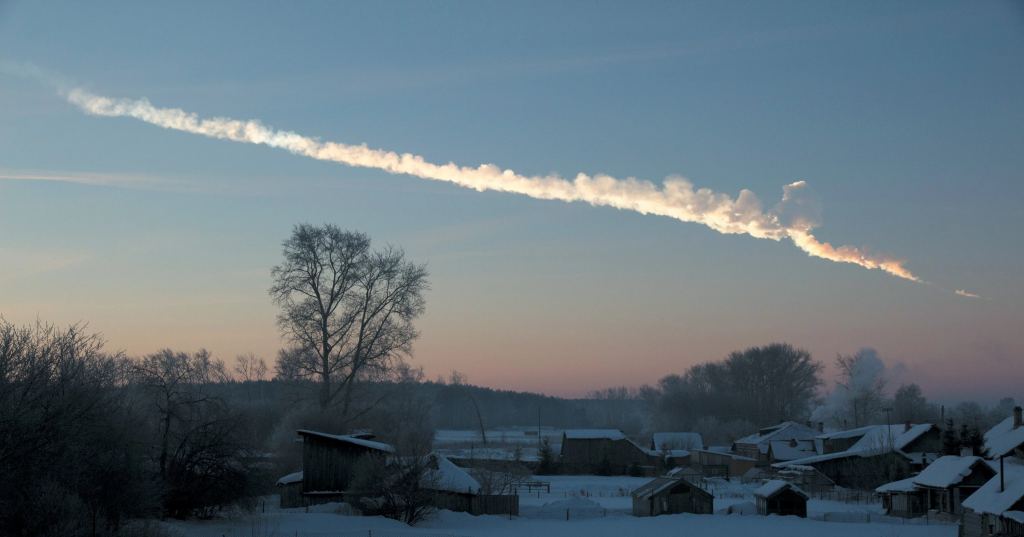
www.universetoday.com
Happy Asteroid Day! Schweickart Prize Spotlights Planetary Defense
Every year on June 30, Asteroid Day marks the anniversary of a meteor airburst in 1908 that leveled hundreds of square miles of Siberian forest land. But a more recent meteor blast — and a new plan for getting advance warning of the next one — is receiving some added attention for this year’s Asteroid Day.
The first-ever Schweickart Prize, named in honor of Apollo 9 astronaut Rusty Schweickart, is going to a researcher who has proposed a system for spotting potentially threatening asteroids coming at us from a difficult-to-monitor zone between Earth and the sun. It was just such an asteroid that blew up over the Siberian city of Chelyabinsk in 2013, spraying debris that injured about 1,500 people and caused an estimated $33 million in property damage.
The proposal from astronomy Ph.D. student Joseph DeMartini calls for setting up a consortium of ground-based observatories, anchored by the Vera C. Rubin Observatory in Chile, to focus on the twilight sky just after sunset and just before sunrise. Those are the times of day when astronomers have the best chance of finding sunward near-Earth objects (NEOs) that spend much of their time within Earth’s orbit.
“It’s a very interesting proposal that we hope gets picked up,” Rusty Schweickart said.
DeMartini’s concept for what he calls the Sunward NEO Surveillance and Early Twilight detection collaboration — or SUNSET for short — was judged the top entry in the competition for the Schweickart Prize. The award, which is a program of the California-based B612 Foundation, recognizes graduate students who come up with innovative ideas for planetary defense. As the prize winner, DeMartini will receive a $10,000 cash prize and a trophy topped by an authenticated meteorite during a ceremony on June 29 at the Chabot Space & Science Center in Oakland, Calif.
“The thing that actually got me to put my idea forward was the meteorite fragment,” said DeMartini, who’s earning his Ph.D. from the University of Maryland. “I saw that and I was like, ‘Oh my gosh, I really want that.’ But maybe that’s just me being an asteroid nerd.”
DeMartini said the idea behind SUNSET came out of discussions he had with a colleague about the asteroid that sparked the Chelyabinsk blast. “The reason we didn’t have any warning was because it came from the direction of the sun, and we can’t look in the direction of the sun,” he said. “That got me thinking, ‘Wow, that’s a region we should really monitor.'”
It turns out that the Rubin Observatory is looking into conducting just such a monitoring effort after it gets up and running next year. DeMartini suggests that the SUNSET network could augment the sightings made at the Rubin Observatory, and confirm the precise orbits traced by sunward NEOs.
“If these other telescopes know where to point in advance, then they can follow up on anything that Rubin discovers in a night, and then we can get these confirmations more easily,” he said.
The current focus of DeMartini’s research actually has to do with a different topic: numerical simulations of asteroid surfaces and interiors, and how close encounters with Earth might change those values. But when his faculty adviser told him about the Schweickart Prize, DeMartini decided to enter the competition.
From left: Apollo 9 astronaut Rusty Schweickart; the Schweickart Prize, topped by a meteorite; and the first winner of the prize, University of Maryland astronomer Joseph DeMartini. (Credits: RustySchweickart.com; Christopher Che via SchweickartPrize.org; University of Maryland)
It should come as no surprise that Rusty Schweickart himself was one of the judges. In his post-NASA career, he has focused on the challenges of asteroid threat detection and mitigation. He’s the founder and past president of the Association of Space Explorers, which took up the NEO threat as one of its causes. He’s also a co-founder of the B612 Foundation, which raises awareness about planetary defense, and a co-founder of Asteroid Day as well.
“What we’re talking about here in planetary defense is having the capability to ever so slightly, but critically, reshape the solar system to enhance the future of life on Earth,” Schweickart said. “To prevent this existential threat — that is what I’ve dedicated the last 20 years of my life to bringing about.”
Thanks in part to a congressional mandate, more than 90% of the biggest near-Earth asteroids, exceeding a kilometer (0.6 mile) in diameter, are thought to have been identified and are being tracked. That’s the kind of asteroid that wiped out the dinosaurs roughly 66 million years ago. “But it’s the ones that are the city-killers — the 40- to 50-meter-diameter guys — that you can’t see until they’re pretty close to the Earth,” Schweickart said. “That means looking interior [to Earth’s orbit] is going to be more productive than looking exterior.”
DeMartini’s proposal was selected as the winner because it addresses one of the biggest gaps in asteroid monitoring, and because it takes advantage of advances in observational firepower.
The Rubin Observatory’s Survey Cadence Optimization Committee, or SCOC, says doing the kind of twilight sky survey that DeMartini discusses in his SUNSET proposal would be “scientifically compelling.” It recommends starting such a survey soon after the telescope begins science operations next year.
“We currently are simulating the effect of adding low-solar-elongation observations during the start and end of twilight, spending about 15 to 20 minutes of the start and end of about a quarter of the survey nights observing at high airmass toward the sun,” Lynne Jones, an astronomer who’s part of the Rubin team, said in an email. “This gives us the opportunity to detect asteroids interior to the Earth, even down to parts of the sky which are closer than 40 degrees from the sun.”
This time-lapse simulation illustrates how the Rubin Observatory could focus on twilight zones at the start and end of a survey night. Credit: Lynne Jones / Aerotek / Rubin Observatory.
DeMartini said the Rubin Observatory’s twilight survey campaign would be “step one” in his vision for the SUNSET collaboration. “The next bit, I suppose, would be networking. Hopefully, this event that I’ll be going to when I’m receiving the prize will be a good opportunity for that. And that’s something that B612 can really help with,” he said.
“If it takes off, I don’t know what it looks like in 10 years. But my hope is that we’re safer because of it,” DeMartini added.
Randy Schweickart, who is one of Rusty’s sons and the chair of the prize program’s judging committee, said he and other family members are committed to funding the Schweickart Prize for at least five years. “The hope is that — similar to the Astronaut Scholarship Foundation, which has expanded tremendously from its beginnings — there would be support from other sources as we move in time and are able to get more of the word out,” he said.
Rusty Schweickart said that the prize is meant for more than astronomers. “The really toughest problems related to planetary defense are the governance issues — the non-technical, geopolitical and legal issues,” he said. “So, in the future, what we want to do is move more in that direction, and get law students, economics students, public-safety people, emergency-response people to be involved in this. Because in the end, they’re going to be very critical.”
Schweickart, who’ll turn 90 next year, hopes the prize will carry on his legacy when he’s “pushing up daisies.”
“It seems to me that that we have, as human beings, a special responsibility to do whatever we can to see that this evolutionary experiment that we’re having here on planet Earth continues,” he said. “I’m not quite sure why that’s the responsibility, but I think it is. And if so, I feel obligated to do what I could.”
Scores of events have been scheduled around the world to mark Asteroid Day, including a two-day festival in Luxembourg. The award ceremony for the Schweickart Prize will take place at 3:30 p.m. PT June 29 at the Chabot Space & Science Center in Oakland, Calif. The event will feature a presentation by Rusty Schweickart, plus comments from NASA astronauts Steve Smith and Nicole Stott, and from YouTube space commentator Scott Manley. Click to purchase tickets.
Founding Sponsors who have funded the Schweickart Prize program include Anousheh Ansari, Barringer Crater Company, B612 Foundation, Future Ventures, Geoffrey Notkin, Jurvetson Family Foundation, Meteor Crater, Randy Schweickart and Michelle Heng, and Rusty B. Schweickart and Joanne Keys.
The post Happy Asteroid Day! Schweickart Prize Spotlights Planetary Defense appeared first on Universe Today.














![San Francisco Punishes Small Business for Having the Nerve to Be Crime Victims [VIDEO]](https://www.rvmnews.com/wp-content/uploads/2024/06/2024.06.19-08.47-rvmnews-667343efa5e73.jpg)
![Biden Tweets and Job Ratings [VIDEO]](https://www.rvmnews.com/wp-content/uploads/2024/06/cAjDs.aiEB-small-Biden-Tweets-and-Job-Rating.jpg)

